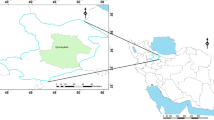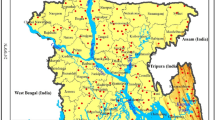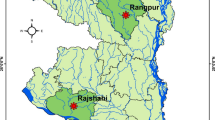Abstract
Groundwater drawdown is a damaging and destructive component in agriculture, demonstrating the necessity for a pattern to assist managers and farmers in predicting the amount of water decrease for proper groundwater planning and management. Because a variety of variables influence the quantity of groundwater drawn down, the current study focuses on human and environmental factors that are useful in forecasting the amount of groundwater levels change within the irrigation network range in the Alborz plain region from 2004 to 2018. Four tree algorithms were employed to forecast changes in groundwater levels. The outcomes of four algorithms in forecasting groundwater level change were evaluated: C5.0 and Classification and Regression Tree (CART), Chi-square Automatic Interaction Detector (CHAID), Quick, Unbiased, Efficient, and Statistical Tree (QUEST). The results for various indices reveal that the performance of the C5.0 algorithm is superior to that of the other methods. The findings of the C5.0 algorithm demonstrate that the volume of agricultural water demand, air humidity, and the amount of water provided to the irrigation network are the three most critical elements determining groundwater level fluctuations. As a result, the proposed method can estimate the amount of change in groundwater levels, which may aid in improved groundwater management and reduce the negative consequences of groundwater drawdown.








Similar content being viewed by others
Abbreviations
- AH:
-
Air humidity (%)
- AT:
-
Air temperature (°C)
- AW:
-
The volume of water discharged from agricultural wells (million cubic meters)
- ER:
-
Error rate
- ET:
-
Potential evapotranspiration (millimetre per day)
- PPV:
-
Positive predictive value or precision
- TNR:
-
True negative rate
- TPR:
-
The true positive rate
- VP:
-
The volume of precipitation (million cubic meters)
- WD:
-
The volume of agricultural water demand (million cubic meters)
- WI:
-
The volume of water delivered to irrigation network (million cubic meters)
References
Aertsen W, Kint V, Orshoven JV, Özkan K, Muys B (2010) Comparison and ranking of different modelling techniques for prediction of site index in Mediterranean mountain forests. Ecol Model 221(8):1119–1130
Afshar FA, Ayoubi S, Besalatpour AA, Khademi H, Castrignano A (2016) Integrating auxiliary data and geophysical techniques for the estimation of soil clay content using CHAID algorithm. J Appl Geophys 126:87–97
Allen RG, Pereira LS, Raes D et al (1998) FAO irrigation and drainage paper no. 56. Food and Agriculture Organization of the United Nations, Rome, vol 56(97), pp 24–25
Bichler A, Neumaier A, Hofmann T (2014) A tree-based statistical classification algorithm (CHAID) for identifying variables responsible for the occurrence of faecal indicator bacteria during waterworks operations. J Hydrol 519:909–917
Bonsor H, MacDonald A, Ahmed K, Burgess W, Basharat M, Calow R, Dixit A, Foster S, Gopal K, Lapworth D et al (2017) Hydrogeological typologies of the indo-gangetic basin alluvial aquifer, south asia. Hydrogeol J 25(5):1377–1406
Bozkir AS, Sezer EA (2011) Predicting food demand in food courts by decision tree approaches. Proc Comp Sci 3:759–763
Chou JS (2012) Comparison of multilabel classification models to forecast project dispute resolutions. Expert Syst Appl 39(11):10202–10211
Dreiseitl S, Ohno-Machado L (2002) Logistic regression and artificial neural network classification models: a methodology review. J Biomed Inf 35:352–359. https://doi.org/10.1016/S1532-0464(03)00034-0
Han J, Kamber M, Pei J (2011) Data mining concepts and techniques, 3rd edn. Morgan Kaufmann, California, p 703
Hassani Y, Hashemy Shahdany SM (2019) Agricultural water distribution under drought conditions based on economic priorities: case study of Qazvin Irrigation District. Irrig Drain 68(3):443–451
Khashei-Siuki A, Sharifan H (2020) Comparison of AHP and FAHP methods in determining suitable areas for drinking water harvesting in Birjand aquifer. Iran Groundw Sustain Dev 10:100328
Konapala G, Mishra AK, Wada Y, Mann ME (2020) Climate change will affect global water availability through compounding changes in seasonal precipitation and evaporation. Nat Commun 11(1):1–10
Kotsiantis SB (2013) Decision trees: a recent overview. Artif Intell Rev 39(4):261–283
Lee S, Lee CW (2015) Application of decision-tress model to groundwater productivity-potential mapping. Sustainability 7(10):13416–13432
Loh WY, Shih YS (1997) Split selection methods for classification trees. Stat Sin 7:815–840
Mirhashemi SH, Mirzaei F (2021) Extracting association rules from changes in aquifer drawdown in irrigation areas of Qazvin plain, Iran. Groundw Sustain Dev. https://doi.org/10.1016/j.gsd.2020.100495
Mirhashemi SH, Haghighat Jou P, Mirzaei F, Panahi M (2020) The study of environmental and human factors affecting aquifer depth changes using tree algorithm. Int J Environ Sci Technol 17(3):1825–1834
Naderi MM, Mirchi A, Bavani ARM, Goharian E, Madani K (2021) System dynamics simulation of regional water supply and demand using a food-energy-water nexus approach: application to Qazvin Plain. Iran J Environ Manage 280:111843
Naghibi SA, Pourghasemi HR, Dixon B (2016) GIS-based groundwater potential mapping using boosted regression tree, classification and regression tree, and random forest machine learning models in Iran. Environ Monit Assess 188(1):1–27
Nampak H, Pradhan B, Manap M (2014) Application of GIS based data driven evidential belief function model to predict groundwater potential zonation. J Hydrol 513:283–300
Novinpour EA (2017) A study of the relationship between the exploitation and subsidence of Salmas. Urban Manage 15(45):319–326
Quinlan JR (1986) Induction of decision trees. Mach Learn 1(1):81–106
Srivastava A, Han EH, Kumar V, Singh V (1999) Parallel formulations of decision-tree classification algorithms. High performance data mining. Springer, Boston, MA, pp 237–261
Stumpp C, Żurek AJ, Wachniew P, Gargini A, Gemitzi A, Filippini M, Witczak SA (2016) decision tree tool supporting the assessment of groundwater vulnerability. Environ Earth Sci 75(13):1057
Sut N, Simsek O (2011) Comparison of regression tree data mining methods for prediction of mortality in head injury. Expert Syst Appl 38(12):15534–15539
Wu X, Kumar V, Ross-Quinlan J, Ghosh J, Yang Q, Motoda H, McLachlan GJ, Ng A, Liu B, Yu PS, Zhou ZH, Steinbach M, Hand DJ, Steinberg D (2009) Top 10 algorithms in data mining. Knowl Inf Syst 14(1):1–37
Acknowledgements
The authors would like to thank the Coordinatorship of the Scientific Research Projects of University Zanjan and Zabol
Author information
Authors and Affiliations
Corresponding author
Ethics declarations
Conflict of interest
There is no conflict of interest for the authors.
Additional information
Editorial responsibility: M. Abbaspour.
Rights and permissions
About this article
Cite this article
Mirhashemi, S.H., Panahi, M. Predicting groundwater level changes within the irrigation network range using the tree algorithm (case study: Alborz plain). Int. J. Environ. Sci. Technol. 19, 9817–9826 (2022). https://doi.org/10.1007/s13762-022-04176-x
Received:
Revised:
Accepted:
Published:
Issue Date:
DOI: https://doi.org/10.1007/s13762-022-04176-x




